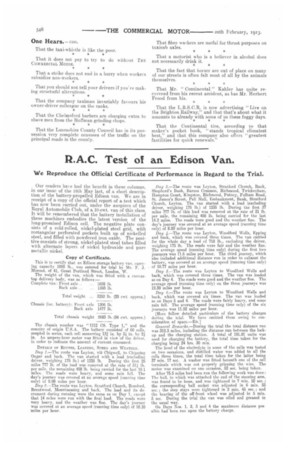R.A.C. Test of an Edison Van.
Page 4

If you've noticed an error in this article please click here to report it so we can fix it.
We Reproduce the Official Certificate of Performance in Regard to the Trial.
Our readers have had the benefit in these columns, in our issue of the 15th May last, of a short description of the battery-propelled Edison van. We are in receipt of a. copy of the official report of a test which has now been carried out, under the auspices of the Royal Automobile Club, of a 1.0-cwt. van of this class. It will be remembered that the battery installation of these machines embodies the latest version of the long-promised Edison cell. The negative plate consists of a cold-rolled, nickel-plated steel grid, with rectangular perforated pockets built up of nickelled steel, and filled with powdered iron oxide. The positive consists of strong, nickel-plated steel tubes filled with alternate layers of nickel hydroxide and pure metallic nickel.
Copy of Certificate.
This is to certify that an Edison storage battery van. carrying capacity 1000 lb., was entered for trial by Mr. F. J. Monnot, of 41, Great Portland Street, London, W.
The weight of the van, which was fitted with a canvastop delivery body, was as follows:— Complete van: Front axle... 1659 lb.
The chassis number wag "1212 CS. Type 1," and the country of origin U.S.A. The battery consisted of 60 cells, coupled in series, each cell measuring 13l in. by 54 in. by 2i in. An ampere-hour meter was fitted in view of the driver. in order to indicate the amount of current consumed.
DETAILS OF ROUTES, LOADING, SPEED AND WEATHER. Day I.—The route was Layton, vife Chigwell, to Chipping 'Ongar and back. The van started with a load (excluding driver, weighing 175 lb.) of 1235 lb. During the first 25 miles 777 lb. of the load was removed at the rate of 34 lb. per mile, the remaining 458 lb. being carried for the last 10.1 miles. The roads were heavy, and some rain fell. The .clay's journey was covered at an average speed (running time only) of 9.98 miles per hour.
Dny f'...--The route was Leyte"), Stratford Church, Rumford, Brentwood, Mountnessing and hack. The load and its deeminent during running were the same as on Day 1, except that 14 miles were run with the final load. The roads were very heavy, and the weather was fine. The day's journey was covered at an average speed (running time only) of 10.10 -miles per hour. Day J.—The route was Leyte'', Stratford Church, Bank, Shepherd's Bash, Barnes Common, Richmond, Twickenham, Hampton Court, Kingston, Richmond, Putney, Fulham Road, St. James's Street, Pall Mall, Embankment, Bank, Stratford Church, Layton. The van started with a load (excluding driver, weighing 175 lb.) of 1235 lb. During, the first 37 miles 777 lb. of this load was removed at the rate of 21 lb. per mile, the remaining 468 lb. being carried for the last 14.2 miles. The roads were good and the weather fine. The day's journey was covered at an average speed (running time only) of 8.89 miles per hour. Day 4.—The route was Layton, Woodford Wells, Epping and back, which was covered three times. The van carried for the whole day a load of 718 lb., excluding the driver, weighing 175 lb. The roads were fair and the weather fine. The average speed (running time only) during the first two journeya was 11.6 miles per hour. The third journey, which also included additional distance run in order to exhaust the battery, was covered at an average speed (running time only) of 10.77 miles per hour.
Day 5.—The route was Leyton to Woodford Wells and back, which was covered three times. The van was loaded as on Day 4. The roads were good and the weather fine. The average speed (running time only) on the three journeys was 12.39 miles per hour.
Day C.—The route was Leyton to Woodford Wells and back, which was covered six times. The van was loaded as on Days 5 and 4. The roads were fairly heavy, and some rain fell. The average speed (running time only) of the six journeys was 11.52 miles per hour.
[Here follow detailed particulars of the battery charges during the trial. We have emitted them owing to consideration of space.—En.]
General Remarks.—During the trial the total distance run was 312.3 miles, including the distance run between the lockup and the charging station. A total of 191.81 units was used for charging the battery, the total time taken for the charging being 24 hrs. 30 min. The level of the electrolyte in some of the cells was tested on two occasions, and distilled water was added to all the cells three times, the total time taken for the latter being 37 min. 17 sec. A washer was fitted beneath one of the cell terminals which was not properly gripping the wire. The motor was examined on one occasion, 52 see, being taken.
After 75.5 miles had been run the following work was done: The hall, to which was attached the end of the steering arm, was found to be loose, and was tightened in 7 min. 10 sec. ; the corresponding ball socket was adjusted in 6 min, 55 see.; the step stays were tightened in 2 min. 45 sec. ; and the bearing of the off-front wheel was adjusted in 5 min. 5 sec. During the trial the van was oiled and greased in the usual way.
On Days Nos. 1, 2, 3 and 4 the maximum distance pos. sible had been run upon the battery charge.
































